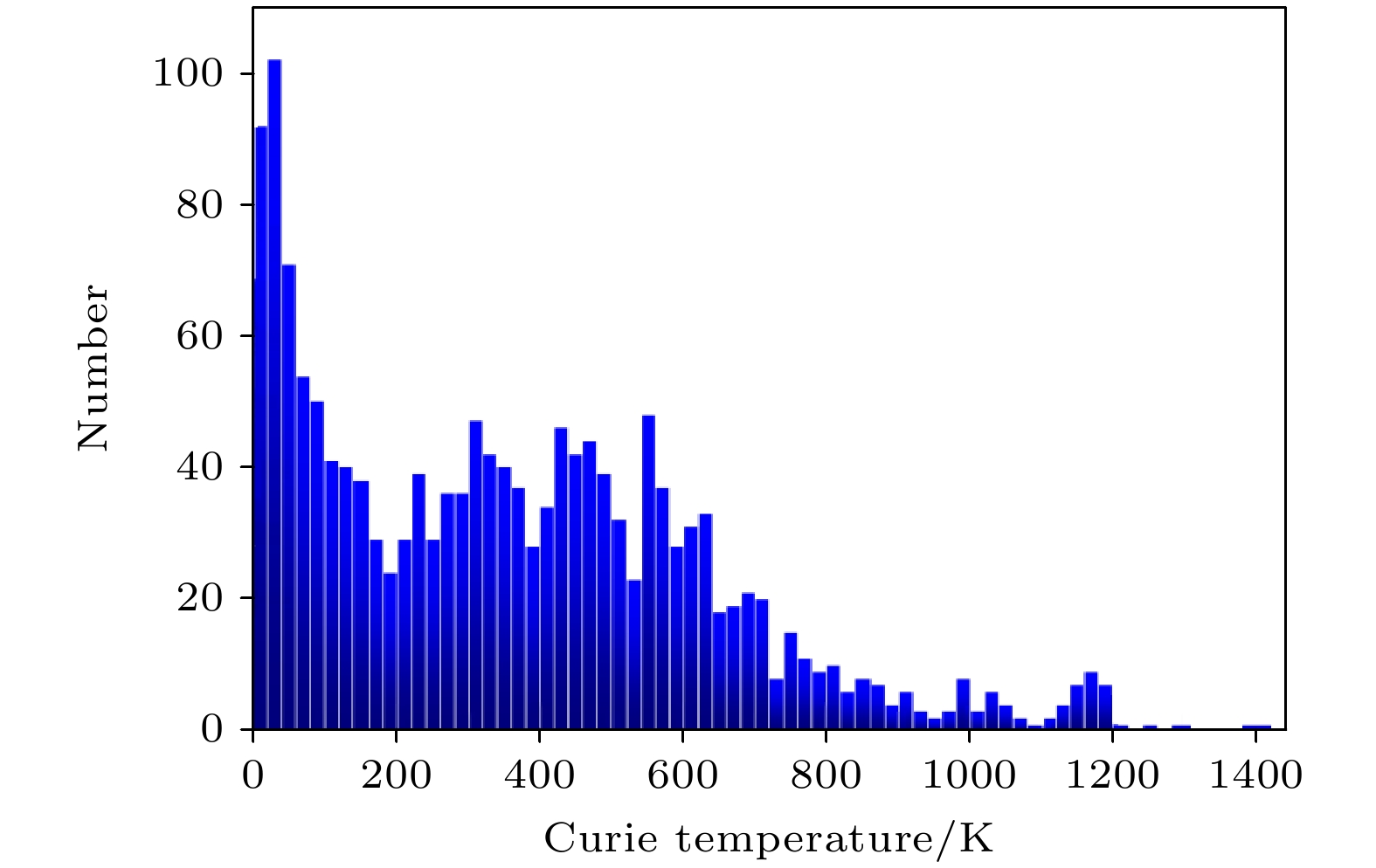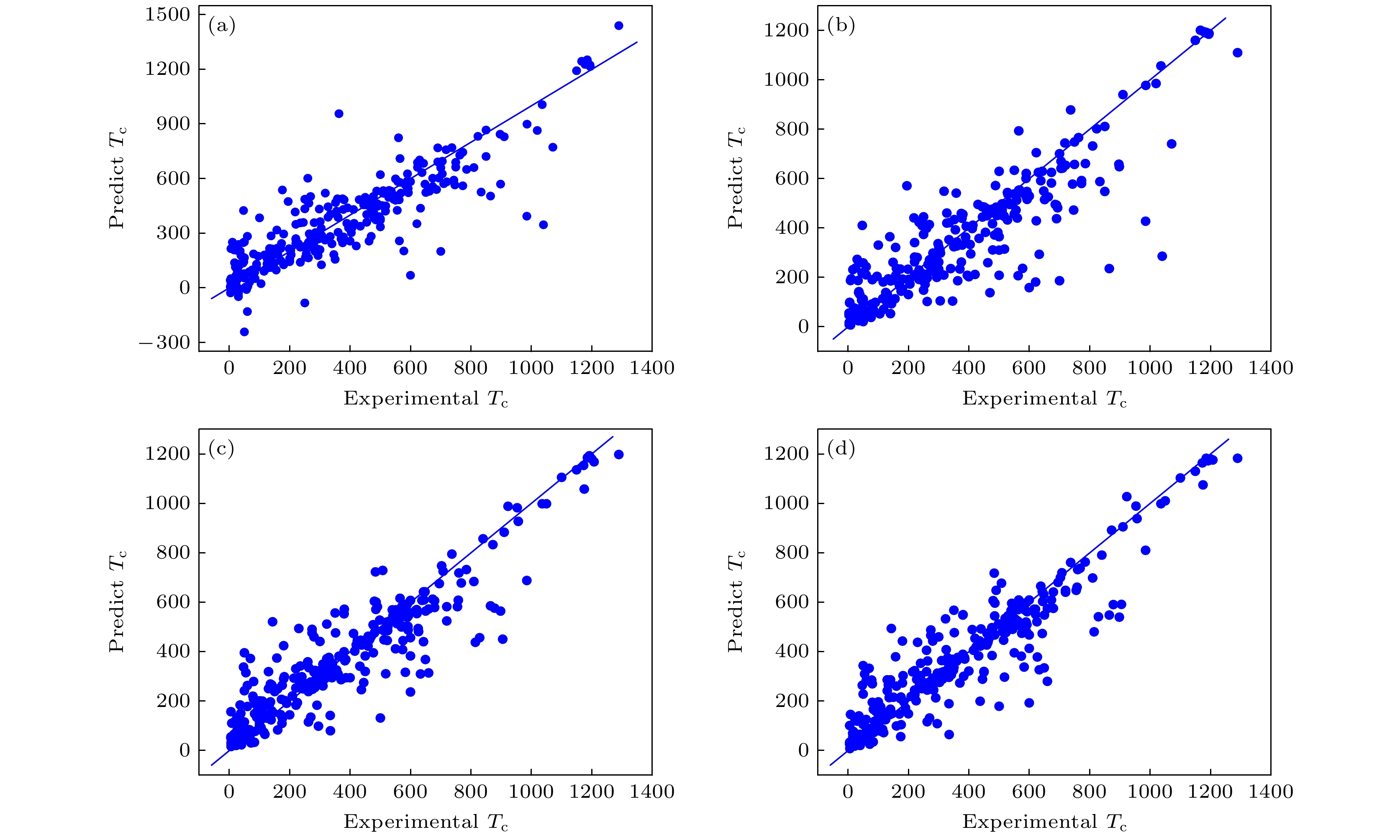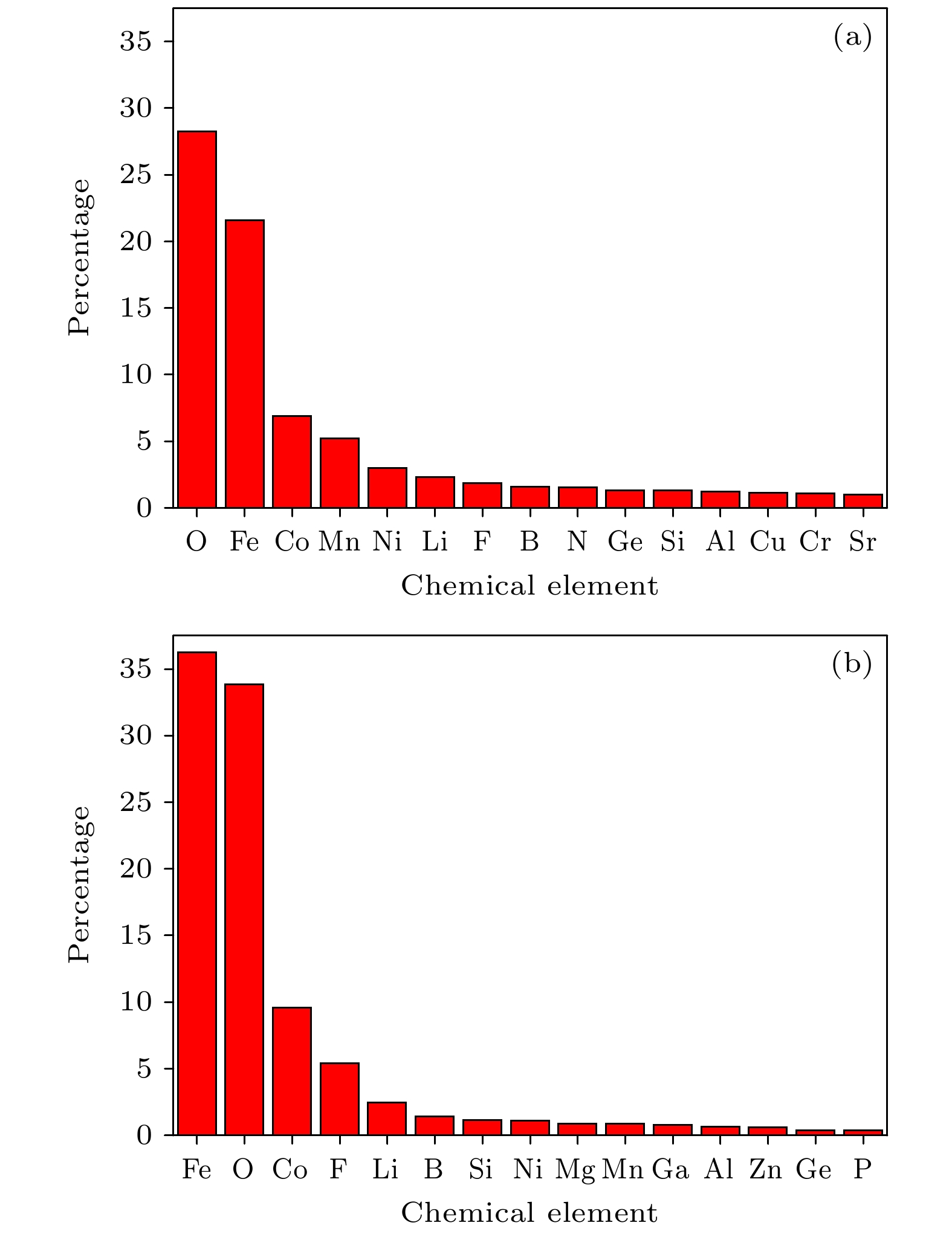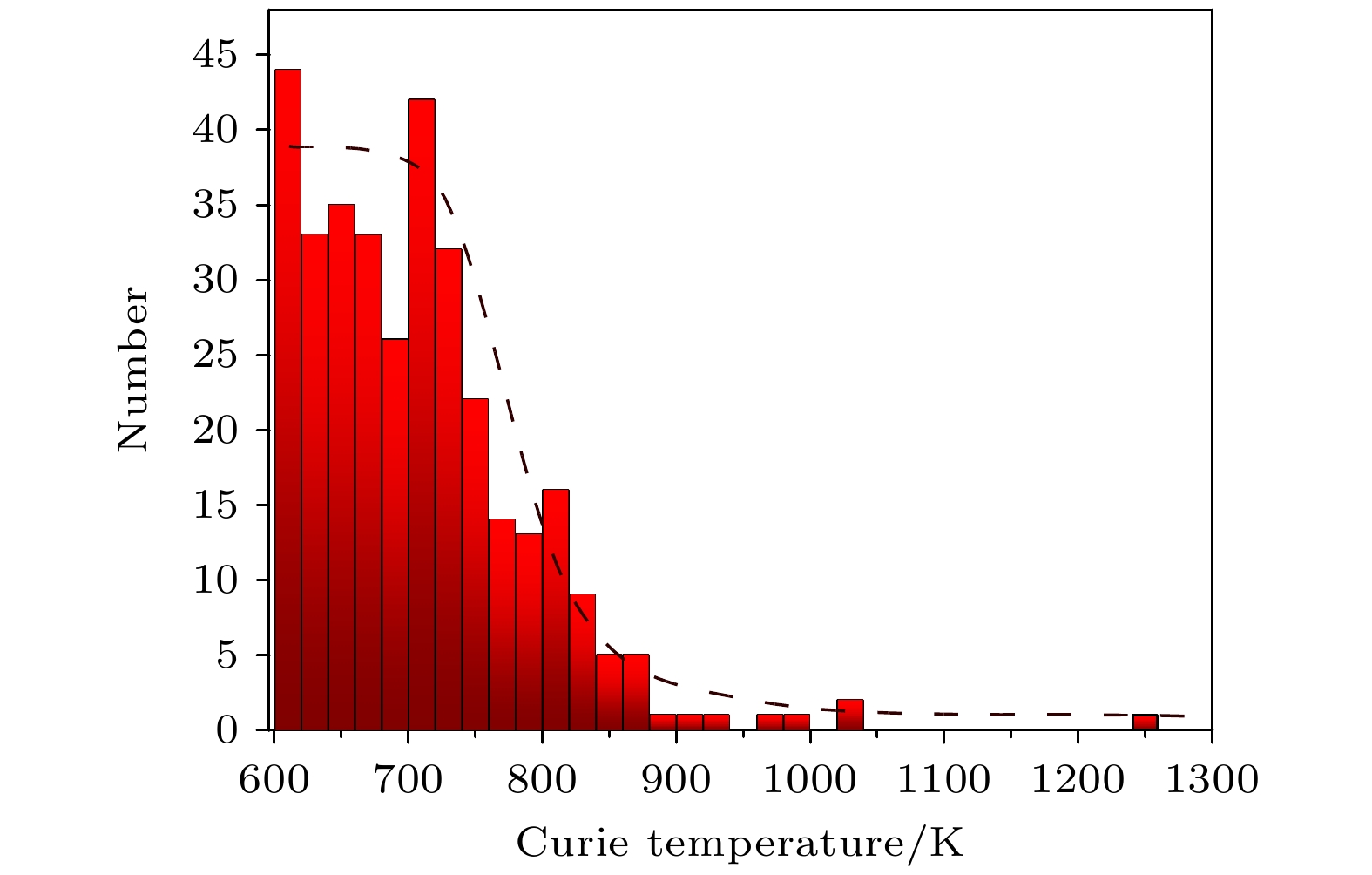-
寻找具有高居里温度的铁磁材料是凝聚态物理的热点问题. 本文建立了有效的基于材料组分信息的居里温度机器学习模型, 并预测了多种高居里温度铁磁材料. 基于收集到的1568个铁磁材料数据, 并以铁磁材料的组分信息作为描述符, 通过超参数优化和十折交叉验证, 构建了支持向量回归、核岭回归、随机森林及极端随机树四种高效的机器学习模型. 这其中, 极端随机树模型具有最好的预测性能, 其交叉验证R2评分可达81.48%. 同时, 还应用极端随机树模型对Materials Project数据库36949种铁磁材料进行了预测, 发现了338个居里温度大于600 K的铁磁材料. 本文提出的方法可以为获取具有高居里温度的铁磁材料提供有价值的帮助, 加快铁磁材料设计的过程.The search for ferromagnetic materials with high Curie temperature (Tc) is a hot issue in condensed matter physics. In this work, an effective machine learning model of Curie temperature based on material component information is established to predict a variety of ferromagnetic materials with high Curie temperature. Based on the collected data of 1568 ferromagnetic materials, and taking the component information of ferromagnetic materials as descriptors, in this work four efficient machine learning models are constructed, namely support vector regression, kernel ridge regression, random forest and extremely randomized trees, through hyperparameter optimization and ten-break cross-validation. Of them, extremely randomized tree model has the best prediction performance, and its cross-validation R2 score can reach 81.48%. At the same time, the extremely randomized tree model is also used to predict 36949 materials in the materials project database, and 338 ferromagnetic materials with Tc greater than 600 K are found in this work. The method proposed in this paper can help obtain ferromagnetic materials with high Curie temperature and accelerate the process of ferromagnetic material design.
-
Keywords:
- machine learning /
- ferromagnetic materials /
- material component /
- Curie temperature
[1] Sanvito S, Oses C, Xue J, Tiwari A, Zic M, Archer T, Tozman P, Venkatesan M, Coey M, Curtarolo S 2017 Sci. Adv. 3 e1602241
 Google Scholar
Google Scholar
[2] Jiang Z, Wang P, Jiang X, Zhao J 2018 Nanoscale Horiz. 3 335
 Google Scholar
Google Scholar
[3] Lu X, Fei R, Yang L 2019 Phys. Rev. B 100 205409
 Google Scholar
Google Scholar
[4] Claussen N, Bernevig B A 2020 Phys. Rev. B 101 245117
 Google Scholar
Google Scholar
[5] Jiang Z, Wang P, Xing J, Jiang X, Zhao J 2018 ACS Appl. Mater. Interfaces 10 39032
 Google Scholar
Google Scholar
[6] Kabiraj A, Kumar M, Mahapatra S 2020 npj Comput. Mater. 6 35
 Google Scholar
Google Scholar
[7] Lu S H, Zhou Q H, Guo Y, Wang J L 2022 Chem 8 769
 Google Scholar
Google Scholar
[8] Lu S H, Zhou Q H, Guo Y L, Zhang Y H, Wu Y L, Wang J L 2020 Adv. Mater. 32 2002658.
 Google Scholar
Google Scholar
[9] Nelson J, Sanvito S 2019 Phys. Rev. Mater. 3 104405
 Google Scholar
Google Scholar
[10] Xue Y F, Shen Z, Wu Z B, Song C S 2022 J. Appl. Phys. 132 053901
 Google Scholar
Google Scholar
[11] Zhang B, Zheng X Q, Zhao T Y, Hu F X, Sun J R, Shen B G 2018 Chin. Phys. B 27 067503
 Google Scholar
Google Scholar
[12] Vishina A, Vekilova O Y, BJörkman T, Bergman A, Herper H C, Eriksson O 2020 Phys. Rev. B 101 094407
 Google Scholar
Google Scholar
[13] Kwon H Y, Kim N J, Lee C K, Won C 2019 Phys. Rev. B 99 024423
 Google Scholar
Google Scholar
[14] Choudhary K, Garrity K F, Ghimire N J, Anand N, Tavazza F 2021 Phys. Rev. B 103 155131
 Google Scholar
Google Scholar
[15] Coey J M D 2011 IEEE Trans. Magn. 47 4671
 Google Scholar
Google Scholar
[16] Buschow K J 2003 Handbook of Magnetic Materials (Amsterdam: Elsevier) pp293–456
[17] Connolly T F 2012 Bibliography of Magnetic Materials and Tabulation of Magnetic Transition Temperatures (New York: Springer Science & Business Media) pp1–30
[18] Long T, Fortunato N M, Zhang Y, Gutfleisch O 2021 Mater. Res. Lett. 9 169
 Google Scholar
Google Scholar
[19] Zhai X, Chen M, Lu W 2018 Comput. Mater. Sci. 151 41
 Google Scholar
Google Scholar
[20] Fabian P, Gaël V, Alexandre G, Vincent M, Bertrand T, Olivier G, Mathieu B, Peter P, Ron W, Vincent D, Jake V, Alexandre P, David C, Matthieu B, Matthieu P, Duchesnay É 2011 J. Mach. Learn. Res. 12 2825
[21] Mirjalili 2019 Enetic Algorithm (Berlin: Springer) pp43–55
[22] Syarif I, Prugel A, Wills G 2016 Telecommun. Comput. Electron. Control 14 1502
 Google Scholar
Google Scholar
[23] 杨自欣, 高章然, 孙晓帆, 蔡宏灵, 张凤鸣, 吴小山 2019 物理学报 68 210502
 Google Scholar
Google Scholar
Yang Z X, Gao Z R, Sun X F, Cai H L, Zhang F M, Wu X S 2019 Acta Phys. Sin. 68 210502
 Google Scholar
Google Scholar
[24] Benesty J, Chen J, Huang Y, Cohen I 2009 Pearson Correlation Coefficient (Berlin: Springer) pp1–4
[25] Jain A, Ong S P, Hautie G, Chen W, Richards W D, Dacek S, Cholia S, Gunter D, Skinner D, Ceder G 2013 APL Mater. 1 011002
 Google Scholar
Google Scholar
[26] Popoel E, Tuszynski M, Zarek W, Rendecki T 1989 J. Less-Common Met. 146 127
 Google Scholar
Google Scholar
[27] Li J G, Pan M X, Sun J R, Zhang F X, Li S P, Zhao D Q, Yu X H, Zhao S X, Chen X C 1996 Solid State Commun. 97 pp1047
 Google Scholar
Google Scholar
[28] Dang M Z, Rancourt D G 1996 Phys. Rev. B 53 2291
 Google Scholar
Google Scholar
[29] Miyata N, Kamimori T, Goto M 1986 J. Phys. Soc. Jpn. 55 2037
 Google Scholar
Google Scholar
[30] Trumpy G, Both E, Djéga-Mariadassou C, Lecocq P 1970 Phys. Rev. B 2 3477
 Google Scholar
Google Scholar
[31] Meinert M 2016 J. Phys. Condens. Matter 28 056006
 Google Scholar
Google Scholar
-
表 1 本研究中四种机器学习模型的超参数
Table 1. Hyperparameters of four machine learning models in this study.
模型 超参数 KRR alpha = 0.00567165, kernel = “rbf” SVR kernel = “rbf”, C = 181.8797945, gamma = 0.18646131 RF n_estimators = 170, max_features = 0.30, min_samples_leaf = 0.001 EXT n_estimators = 180, max_features = 0.58, min_samples_leaf = 0.001 表 2 基于特征筛选获得的化学参数描述符
Table 2. Chemical parameter descriptors obtained based on feature screening.
No. Meanings Features 1 Mean atomic number MAN 2 Mean IonicRadius MIR 3 Mean Modulus of Elasticity MME 4 Mean melting point MMP 5 Mean GSmagmom MGSM 6 Mean covalentradius MCR 7 Mean IonizationEnergy MIE 8 Mean ElectronAffinity MEA 9 Mean AtomicVolume MAV 10 Mean MendeleevNumber MMN 11 Composition of Mn CMn 12 Composition of Fe CFe 13 Composition of Co CCo 14 Composition of Ni CNi 15 range AtomicRadius RAR 16 range Electronegativity REE 17 avg p valence electrons ApV 18 avg d valence electrons AdV 19 frac f valence electrons FfV 20 transition metal fraction TMF 21 2-norm 2N 表 3 本研究中四种机器学习模型的最终评估结果
Table 3. Final evaluation results of four machine learning models in this study.
KRR SVR RF EXT MAE 89.43 83.21 76.52 70.86 RMSE 125.50 125.77 114.71 109.32 R2/% 80.75 80.67 83.92 85.39 CS MAE 95.41 88.64 81.18 74.04 CS RMSE 141.21 137.62 124.13 117.98 CS R2/% 73.70 74.92 79.45 81.48 -
[1] Sanvito S, Oses C, Xue J, Tiwari A, Zic M, Archer T, Tozman P, Venkatesan M, Coey M, Curtarolo S 2017 Sci. Adv. 3 e1602241
 Google Scholar
Google Scholar
[2] Jiang Z, Wang P, Jiang X, Zhao J 2018 Nanoscale Horiz. 3 335
 Google Scholar
Google Scholar
[3] Lu X, Fei R, Yang L 2019 Phys. Rev. B 100 205409
 Google Scholar
Google Scholar
[4] Claussen N, Bernevig B A 2020 Phys. Rev. B 101 245117
 Google Scholar
Google Scholar
[5] Jiang Z, Wang P, Xing J, Jiang X, Zhao J 2018 ACS Appl. Mater. Interfaces 10 39032
 Google Scholar
Google Scholar
[6] Kabiraj A, Kumar M, Mahapatra S 2020 npj Comput. Mater. 6 35
 Google Scholar
Google Scholar
[7] Lu S H, Zhou Q H, Guo Y, Wang J L 2022 Chem 8 769
 Google Scholar
Google Scholar
[8] Lu S H, Zhou Q H, Guo Y L, Zhang Y H, Wu Y L, Wang J L 2020 Adv. Mater. 32 2002658.
 Google Scholar
Google Scholar
[9] Nelson J, Sanvito S 2019 Phys. Rev. Mater. 3 104405
 Google Scholar
Google Scholar
[10] Xue Y F, Shen Z, Wu Z B, Song C S 2022 J. Appl. Phys. 132 053901
 Google Scholar
Google Scholar
[11] Zhang B, Zheng X Q, Zhao T Y, Hu F X, Sun J R, Shen B G 2018 Chin. Phys. B 27 067503
 Google Scholar
Google Scholar
[12] Vishina A, Vekilova O Y, BJörkman T, Bergman A, Herper H C, Eriksson O 2020 Phys. Rev. B 101 094407
 Google Scholar
Google Scholar
[13] Kwon H Y, Kim N J, Lee C K, Won C 2019 Phys. Rev. B 99 024423
 Google Scholar
Google Scholar
[14] Choudhary K, Garrity K F, Ghimire N J, Anand N, Tavazza F 2021 Phys. Rev. B 103 155131
 Google Scholar
Google Scholar
[15] Coey J M D 2011 IEEE Trans. Magn. 47 4671
 Google Scholar
Google Scholar
[16] Buschow K J 2003 Handbook of Magnetic Materials (Amsterdam: Elsevier) pp293–456
[17] Connolly T F 2012 Bibliography of Magnetic Materials and Tabulation of Magnetic Transition Temperatures (New York: Springer Science & Business Media) pp1–30
[18] Long T, Fortunato N M, Zhang Y, Gutfleisch O 2021 Mater. Res. Lett. 9 169
 Google Scholar
Google Scholar
[19] Zhai X, Chen M, Lu W 2018 Comput. Mater. Sci. 151 41
 Google Scholar
Google Scholar
[20] Fabian P, Gaël V, Alexandre G, Vincent M, Bertrand T, Olivier G, Mathieu B, Peter P, Ron W, Vincent D, Jake V, Alexandre P, David C, Matthieu B, Matthieu P, Duchesnay É 2011 J. Mach. Learn. Res. 12 2825
[21] Mirjalili 2019 Enetic Algorithm (Berlin: Springer) pp43–55
[22] Syarif I, Prugel A, Wills G 2016 Telecommun. Comput. Electron. Control 14 1502
 Google Scholar
Google Scholar
[23] 杨自欣, 高章然, 孙晓帆, 蔡宏灵, 张凤鸣, 吴小山 2019 物理学报 68 210502
 Google Scholar
Google Scholar
Yang Z X, Gao Z R, Sun X F, Cai H L, Zhang F M, Wu X S 2019 Acta Phys. Sin. 68 210502
 Google Scholar
Google Scholar
[24] Benesty J, Chen J, Huang Y, Cohen I 2009 Pearson Correlation Coefficient (Berlin: Springer) pp1–4
[25] Jain A, Ong S P, Hautie G, Chen W, Richards W D, Dacek S, Cholia S, Gunter D, Skinner D, Ceder G 2013 APL Mater. 1 011002
 Google Scholar
Google Scholar
[26] Popoel E, Tuszynski M, Zarek W, Rendecki T 1989 J. Less-Common Met. 146 127
 Google Scholar
Google Scholar
[27] Li J G, Pan M X, Sun J R, Zhang F X, Li S P, Zhao D Q, Yu X H, Zhao S X, Chen X C 1996 Solid State Commun. 97 pp1047
 Google Scholar
Google Scholar
[28] Dang M Z, Rancourt D G 1996 Phys. Rev. B 53 2291
 Google Scholar
Google Scholar
[29] Miyata N, Kamimori T, Goto M 1986 J. Phys. Soc. Jpn. 55 2037
 Google Scholar
Google Scholar
[30] Trumpy G, Both E, Djéga-Mariadassou C, Lecocq P 1970 Phys. Rev. B 2 3477
 Google Scholar
Google Scholar
[31] Meinert M 2016 J. Phys. Condens. Matter 28 056006
 Google Scholar
Google Scholar
计量
- 文章访问数: 6413
- PDF下载量: 127
- 被引次数: 0














 下载:
下载:






